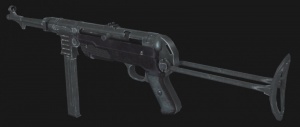Maschinenpistole 40

| |
| Maschinenpistole 38/40 | |
| Specifications | |
| Type | Submachine Gun |
| Caliber | 9mm |
| Feed System | 32 Round Magazine |
| Rate of Fire | 600-700 Rounds/Min |
| Muzzle Velocity | 390m/s |
| Maximum Effective Range | 200m |
History
Hugo Schmeisser’s 1917 Maschinenpistole (Machine Pistol, MP) 18 became the prototype for almost every subsequent submachine gun in the world.
In 1927, Heinrich Vollmer and Berthold Giepel, manager of Erfurt Maschinenwerk (Erma), patented the design of a selective-fire submachine gun similar in layout to the MP 18 with the bolt, firing pin, and return spring a self-contained unit enclosed within a single telescoping tubular casing. During disassembly, the bolt and spring could be lifted out as a unit, reducing danger to the operator, and the arrangement proofed most of the working parts against dust and dirt. Erma’s 1935 model took advantage of a perforated barrel jacket and some safety modifications. The 1935 model was bought by Yugoslavia and France, which issued it as the Pistolet mitrailleur (Submachine Pistol) Vollmer Erma.
Germany had begun to develop tactics that called for speedy infantry with plenty of automatic firepower - and the submachine gun was easy for untrained men to learn to use. In 1938, the Oberkommando der Wehrmacht (Wehrmacht High Command, OKW) issued a specification for a submachine gun suited to mobile warfare. The Germans chose Erma’s automatic-fire-only design which, upon entering service August 1938 as the MP 38, became the first submachine gun to play a major role in a first-grade army.
In a nod to the future, the MP 38 eschewed wood in favor of plastic and employed a folding metal butt. It retained the blow-back mechanism and telescopic bolt assembly. Below the barrel, a lug prevented the weapon from inadvertently moving inboard while firing from the gun port of an armored vehicle. A 32-round box magazine inserted below the receiver fed ammo.
MP 38 production used traditional gunsmithing methods and took an unacceptable length of time to make. The MP 40 was essentially the same gun as the MP 38, although stamped rather than tooled and with design changes that rendered the gun less likely to fire when jolted. Visually, the only difference was that the MP 40 had four horizontal ridges on the magazine receptacle. Distribution of the MP 40 began in mid 1940. All MP 38s were eventually converted to the MP 40 standard in time.
The MP 38/40s offered the operator accurate and stable fire, even when loosing prolonged bursts. The weapons’ biggest weakness was the magazine/receiver interface which would occasionally jam on dirt or the cylindrical Parabellum cartridges.
Allied troops called these guns “Schmeissers”, presumably after World War I’s MP 18s. In fact, that nickname is as inaccurate as is calling an F-15 a “Douglas” today.
Game Play
In game you can use this weapon if select the SMG. Normally this is best used in cityscapes and can kill anti-tank and anti-aircraft gun crews. In an open field battle, it performs worse than the Mauser rifle.